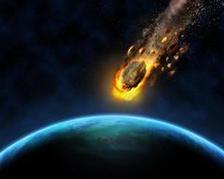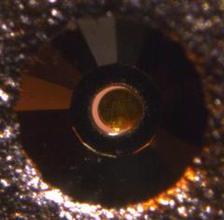Artist´s image of an asteroid approaching the earth. (Image by kjpargeter on Freepik)
A research team from DESY and the University of Jena has for the first time demonstrated live the formation of the mineral stishovite (a form of silicon dioxide or silica, SiO2), which is often used as a mineral to detect ancient asteroid and meteorite impacts on the Earth's surface. The researchers observed the formation of the mineral using time-resolved X-ray diffraction experiments at DESY's high-power X-ray source PETRA III while subjecting quartz to rapid compression. In their study, the scientists revealed for the first time the structural evolution of the ubiquitous mineral quartz as the pressure is increased to stishovite, solving a decades-old enigma of how stishovite can form directly from quartz during an asteroid or meteorite impact. Published in the Journal of Geophysical Research: Planets, the work is of great importance for estimating the extent of impacts and contributes to a better understanding of rapid compression events in other mineral systems.
Every planet has to endure impacts of smaller objects, such as meteorites and asteroids, on its surface many times over the course of its history. “While these impacts are visible as craters on the moon, they have almost disappeared on the Earth's surface because erosion, weathering and plate tectonics have erased these large-scale features,” explains Falko Langenhorst from the University of Jena, one of the authors of the study. However, an impact not only changes the surface of a planet, but also the minerals that make up its planetary crusts – a stroke of luck for researchers. This is because the ubiquitous mineral quartz first transforms into an intermediate structure of silica, which has the same crystal structure as a similar trigonal mineral called rosiaite, and then finally changes into the high-pressure mineral stishovite. Both forms of silica, or rather their amorphous decompression products, have been detected in the Barringer impact crater in the USA and the Nördlinger Ries in Germany.
However, for a long time it was completely unclear how the amorphous degradation products of the rosiaite-form mineral, products which are called planar deformation lamellae (PDF), and stishovite can form at the same location and how the two could be related to each other. “This is particularly true because the researchers believed that stishovite can only form when quartz is heated to a high temperature under high pressure. This happens after the initial impact during a phase of melting and renewed crystallisation of SiO2 to form stishovite,” argues the first author of the paper, Christoph Otzen, a doctoral student at DESY and the University of Jena. In initial, pioneering field experiments at the end of the 1960s, the researchers suspected stishovite was present in the PDFs in nature. However, they were unable to explain their formation, as the researchers could not generate the PDFs when their sample was heated to form stishovite. The researchers now wanted to unravel this mystery with their high-pressure experiments at PETRA III.
The experiments on the rapid compression of quartz single crystals between two opposing diamond anvil have solved the mystery,” explains Hanns-Peter Liermann, head of the PETRA III beamline P02.2 and co-author of the study. “With the very intense X-ray radiation from PETRA III, we were able to follow the crystallographic changes during the compression of quartz in real time,” describes Liermann. “We found that the quartz crystals must be compressed along a specific crystallographic orientation to enable the formation of stishovite from the rosiaite-structured silica. In our earlier experiments, the formation of stishovite could not be observed. Only when we chose a different crystallographic orientation were we able to generate locally high temperatures by shearing in the rosiaite-structured silica and thus observe the formation of very small strings of almost perfect stishovite crystals. These crystals were then correlated with the PDFs by analysing the recovered sample using a transmission electron microscope,” explains Langenhorst.
The formation of stishovite from metastable silica with a rosiaite structure through a solid-state transformation is of great significance for assessing the extent of earlier asteroid impacts. Until now, researchers believed that stishovite only forms at very high pressure. However, the study shows that not only the pressure is decisive for the formation of this indicator mineral, but also the orientation of the base material to the shock front. This means that the absence of stishovite does not necessarily mean that the force of the impact was low. Only the frequency of PDFs and the presence of stishovite make it possible to estimate the pressure prevailing during the impact, even if the morphology of the impact crater itself is no longer visible. “In addition, the solid-state transformation can also model what happens in other mineral systems such as feldspars, which are also part of sediments and which are also significantly crystallographically altered by an asteroid impact,” explains Otzen. This new approach of simulating asteroid impacts using single crystals in a rapidly compressed diamond anvil cell opens up a new branch of research in the field of impact simulations and emphasises the importance of quartz as a unique crystalline indicator of asteroid impacts.
(Partly from DESY News)
Reference:
A new mechanism for stishovite formation during rapid compression of quartz and implications for asteroid impacts; Christoph Otzen, Hanns-Peter Liermann, Falko Langenhorst; Journal of Geophysical Research: Planets, 129 (2024) DOI: 10.1029/2023JE008126








